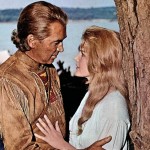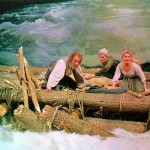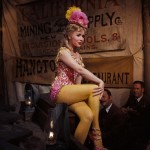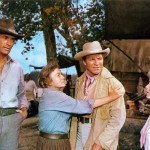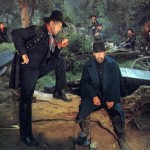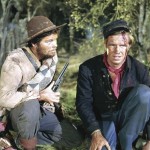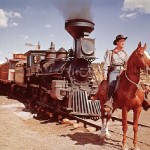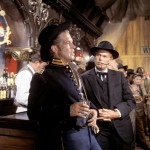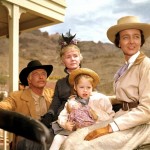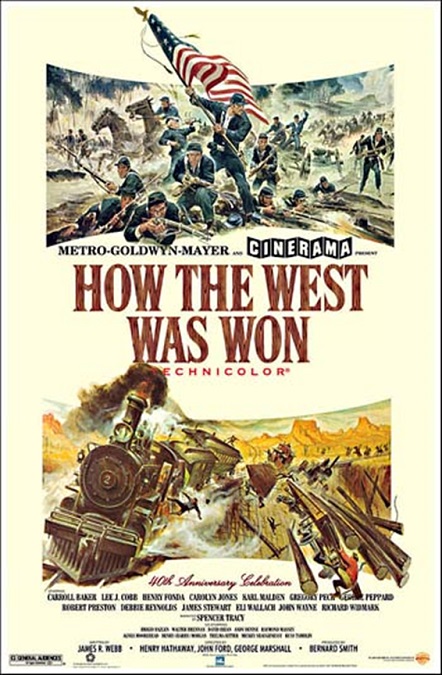
How the West Was Won – 1962
This was a well-made movie with a huge cast of huge names. Somehow, they got some of the biggest stars in Hollywood to take small roles and bit parts. People like John Wayne, James Stewart, Gregory Peck, Henry Fonda, Karl Malden, Robert Preston, Carroll Baker, Carolyn Jones, Agnes Moorhead, Harry Morgan, Debby Reynolds, George Peppard, Eli Wallach, Richard Widmark, Andy Divine, Russ Tamblyn, and Spencer Tracy made for an epic film that was pretty impressive in its scope and scale.
The film was made up of 5 vignettes, each one a story in itself, telling of a different aspect of how early American settlers tamed and colonized the western frontier. Each story had a connecting thread that began with the Prescott family and continued with their descendants. First was The Rivers of 1839, followed by The Plains of 1851. Next came the Civil War between 1861 and 1865. After that was the Railroads in 1868. And finally came the Outlaws in 1889. Each story was good enough to have been expanded into an entire film, but they were told short and sweet. They were interesting and easily followed. Actors and actresses came and went, but the common thread of the single family that ran through them all gave the film a tight cohesiveness.
In part one, the family started out with the parents, Zebulon Prescott and his wife Rebecca, played by Malden and Moorehead. Their two daughters, Eve and Lilith, are played by Baker and Reynolds. At the end of part one, Eve marries Linus Rawlings, played by Stewart. In part two, Lilith marries Cleve Van Valen, played by Peck. In part three, Linus and later, his son Zeb, played by Peppard, joins the Union Army. In part four, Zeb tries to make peace with Indians as the Railroads are being built. And in part five, we learn that Cleve and Lilith have become wealthy as railroad tycoons, but have fallen on hard times. Cleve is dead and Lilith moves to her ranch in Arizona along with her nephew Zeb, who has become a US Marshall. He is married to Julie, played by Jones, and after fighting to take down a gang of dangerous outlaws, they all ride off into the sunset.
And that’s the basic story line. The rest of the big name actors all took smaller roles. For example, John Wayne played General Sherman in the Civil War story. Robert Preston played a Roger Morgan, a wagonmaster crossing the plains with Lillith. Henry Fonda played Jethro Stewart, a buffalo hunter who helped Zeb make peace with the Indians. Eli Wallach played Charlie Gant, the head of the gang of outlaws who fought with Zeb.
Three of the vignettes were directed by Henry Hathaway, one by John Ford, and one by George Marshall. But unless you are well versed in their various directing styles, you’d never notice any of the differences. The stories were distinct, and yet they all fit together like a kind of jigsaw puzzle, eventually presenting us with a larger image.
One of the things that really caught my attention was the incredible cinematography. Some of the wide open shots of the beautiful and scenic American geography were stunning. The movie was one of only two dramatic feature films ever to be filmed in a new and innovative process called Cinerama. Unfortunately the process could only be effective if shown on a special curved screen. When shown on a flat screen, the actors didn’t seem to be looking at each other. There were also wide shots in which the image on the screen was drastically curved, giving it a fish-eye effect.
The acting was top-notch. I especially liked Reynolds and Baker. Reynolds’ character, Lilith, was the only character to be alive in all 5 vignettes, though she only appeared in 3. The movie had the advantage of star power and it used it to the fullest. Even Spencer Tracy, who did not appear on-screen, was the narrator who helped with the transitions between the different segments, and he did a wonderful job.
The feel of the epic reflected the manifest destiny of the American settlers, which said that we were meant to be the masters of the land simply because we were, and yet it was honest at the same time. There were good people and bad, and some people who were a bit of both. The movie well-made and just fun to watch.
